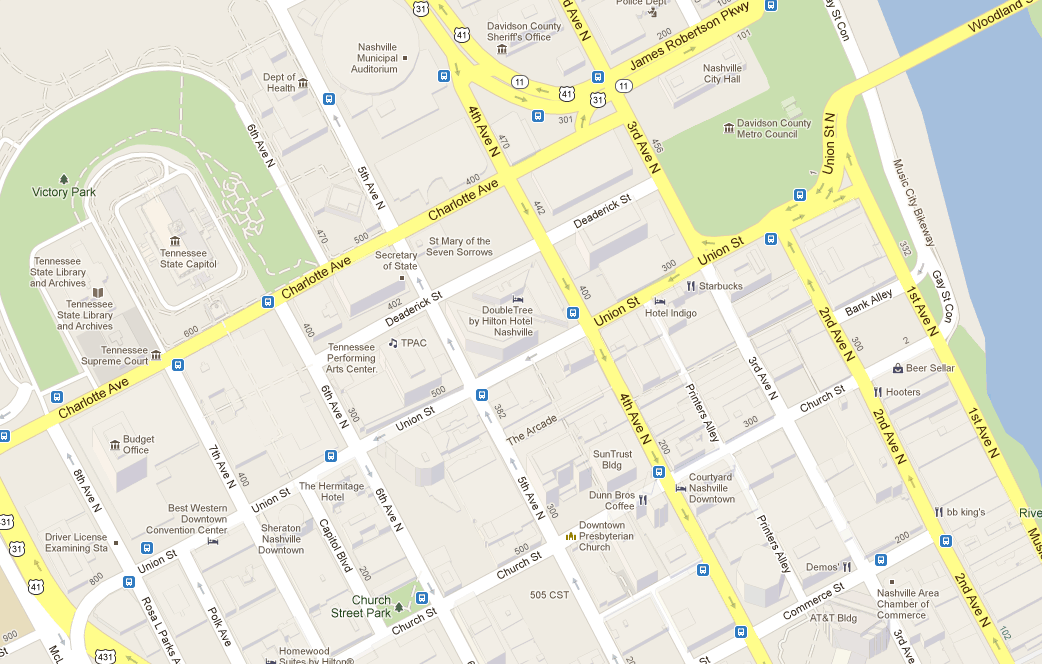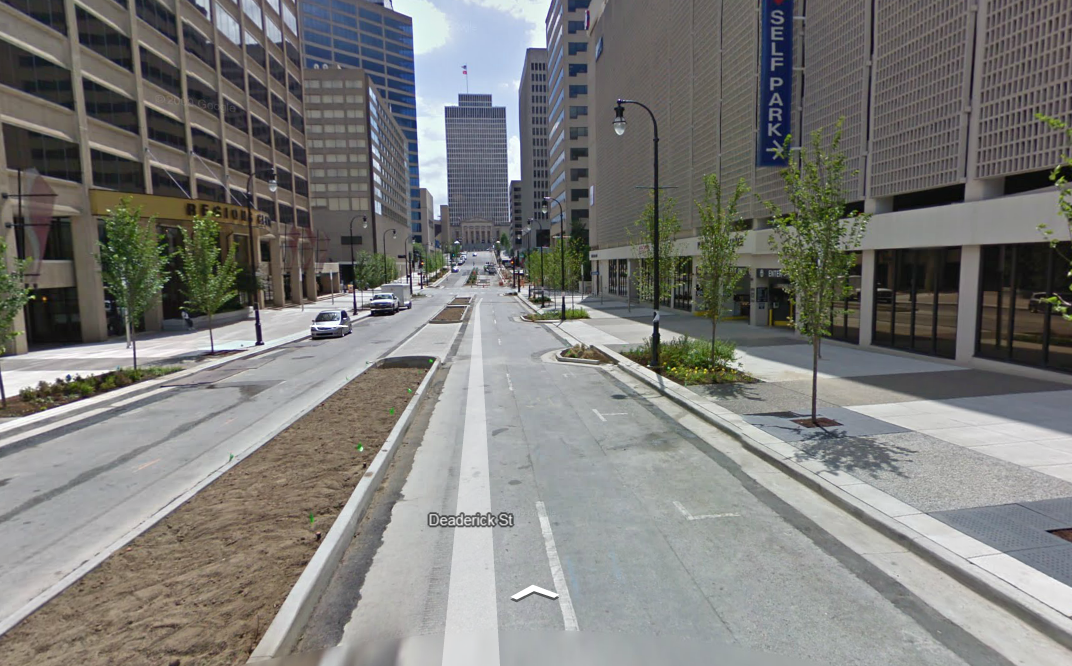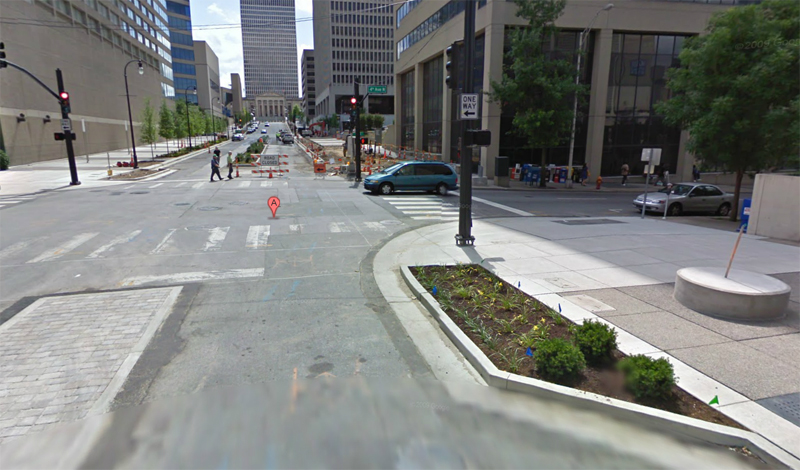Background
Deaderick Street is an urban core streetthat serves as a physical connector between the city/county courthouse and the state legislature. This street was a central transfer point for the Metro bus system. It was filled with empty bus shelters, had no trees, and had a storm water and sewage overflow problem. However, the street was transformed into one of the most sustainable and livable streets in the downtown area in 2009, one year after the city decided to relocate the bus system’s hub one block. Now the streetscape has 102 trees, 4,249 shrubs and perennials and all LED lights.
Adopted from: Jenny Burns 2009, Nashville Business Journal
Hawkins Partners, Inc., worked with the Office of the Mayor and Metro Public Works to transform the historically and civically significant corridor. Deaderick Street is situated within the Kerrigan Basin, one of Nashville’s Combined Storm Sewer basins, where had overflow problems. The project primarily focused on addressing storm water issues and urban trees. Based on Nashville’s historical rainfall patterns, infiltration rates and variable design factors, it is estimated that over 1.2 million gallons will be removed from the CSO system on an annual basis through this three block urban street (Hawkins).
Adopted from: Jenny Burns 2009, Nashville Business Journal
Project Highlights
Who: Metro Nashville Public Works
When: October 2008 to October 2009
General contractor: Roy T. Goodwin Contractors, Nashville, TN
Landscape architect: Hawkins Partners Inc., Nashville, TN
Project budget: Under $5 million ($3.1 million in capital improvement funds)
- Provided a 700% increase in pervious area (diverting approximately 1.2 million gallons of storm water from the Cumberland River per year).
- Incorporated bioswales (Rain gardens) at sidewalk level planting areas and at street level to capture, filter and infiltrate rainwater.
- Used porous concrete used to allow water infiltration through sidewalk to tree root zones.
- Planted 102 4-inch caliper shade trees, and 4249 shrubs, perennials, sedges, and groundcover plants.
- Native plants comprise 53% of the species installed.
- Some healthy, existing street trees were transplanted.
- Other elements included:
- Irrigation: low flow nozzles (33% less water), drip system and soil moisture probe.
- Pedestrian streetlights and guidance signs are LED.
- LED traffic signals.
- Solar-powered parking meters.
- Recycled, crushed concrete used for sub-base for concrete walks.
- High percentage recycled steel used in pedestrian light poles, tree grates, fence, trash/recycling containers, pedestrian guidance signs.
- Recycled coal fly ash within the concrete.
- Bicycle storage facilities.
- Educational kiosks that explain the benefits of urban trees, rain gardens, and sustainable infrastructure.
Adopted from: City of Nashville (http://www.nashville.gov/pw/pdfs/projects/DeaderickStreetscapeImprove.pdf)
This plan also focused on creating a multipurpose environment that would draw people in. The long-term master plan proposed additional development potential of 40,000 square feet of retail and restaurant uses, 11,000 square feet of office use, and 94 residential housing units. The street can be a venue for occasional events and festivals. The removal of the transit mall reduced average daily traffic volume, creating a more pedestrian-friendly environment and providing more on-street parking. Yet, business owners share differing opinions. There is an increase in tourists with concerts and other events to the street. But some owners said business was better when the bus transit center was there.
Adopted from: Elizabeth Johnson, The Tennessean
Potential Benefits:- Promotes sustainable and livable streets through low-impact design.
- Generates less traffic and thus more pedestrian-friendly environment.
- Brings tourism money to the downtown area through events and festivals.
- Prevents water sewage problems.
- Implements the plan block-by-block to allow as much of the street as possible to remain open during construction.
- Serves as one of four Tennessee projects to be accepted as pilot projects for The Sustainable Sites Initiative (Johnson 2010).
Potential Issues:
- Business impact: The relocation of the transit center had a negative impact on businesses in the area.
- Code and regulation amendments: Amendments may be required to allow more street activities like outdoor dining (Hawkins).
Sources
Burns, Jenny, 2009. “Deaderick Hailed as State's First 'Green Street',” Nashville Business Journal (http://www.bizjournals.com/nashville/stories/2009/10/05/daily27.html).
Green Infrastructure Digest. “Deaderick Street Discussed at StormCon 2010” (http://hpigreen.com/tag/deaderick-street/)
Hawkins, Kim. “Nashville Creates Tennessee's First ‘Green’ Street.” Public Works (http://pwmag.com/industry-news.asp?sectionID=760&articleID=1537236&artnum=1)
Johnson, Elizabeth, 2010. “Renovated Deaderick Street Enhances Nashville's City Core,” The Tennessean (http://www.tennessean.com/article/20100615/DAVIDSON/100615071/Renovated-Deaderick-Street-enhances-Nashville-s-city-core)
Nashville. “Deaderick: Tennessee’s First ‘Green Street’” (http://www.nashville.gov/pw/pdfs/projects/DeaderickStreetscapeImprove.pdf)
Photo Sources
MIG, Inc.



